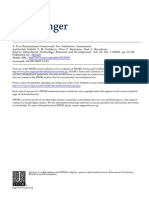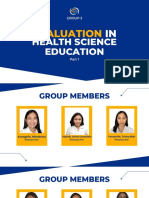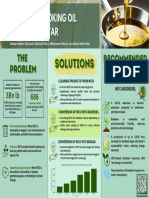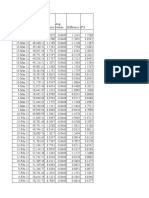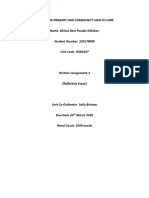Professional Documents
Culture Documents
Poster
Poster
Uploaded by
api-7434319710 ratings0% found this document useful (0 votes)
11 views1 pageOriginal Title
poster
Copyright
© © All Rights Reserved
Available Formats
PDF, TXT or read online from Scribd
Share this document
Did you find this document useful?
Is this content inappropriate?
Report this DocumentCopyright:
© All Rights Reserved
Available Formats
Download as PDF, TXT or read online from Scribd
Download as pdf or txt
0 ratings0% found this document useful (0 votes)
11 views1 pagePoster
Poster
Uploaded by
api-743431971Copyright:
© All Rights Reserved
Available Formats
Download as PDF, TXT or read online from Scribd
Download as pdf or txt
You are on page 1of 1
The effects of formative assessment on students’
attitude towards learning and design skills:
Perspective from a Senior-level Electrical Engineering design-based course
Muhammad Zilany, Iqra Mohammed Yakub, Syed Umer Ahmed
Electrical and Computer Engineering Program, Texas A&M University at Qatar, P.O. Box 23874, Doha, Qatar
INTRODUCTION RESULTS DISCUSSION
In the realm of education, assessment plays a pivotal role, An initial examination of data obtained from two modules
serving as a fundamental tool employed by both educators Preliminary analysis of the data from modules with formative assessment shows positive impacts of applying incorporating formative assessments reveals favorable outcomes
and students. . It functions as a means to provide essential linked to the utilization of these assessments in terms of students'
formative assessments toward students’ learning and design skills. Since formative assessment gives the
feedback that guides the ongoing learning process, enabling learning and their development of design skills. The incorporation
instructors to tailor their teaching methods to achieve the
teacher the ability to provide continuous feedback to their students, the students become part of the learning of formative assessments empowers instructors to offer continuous
planned educational objectives (Robinowitz, 2010; Black, environment and improve self-assessment strategies that will help with the understanding of their own thinking feedback to their students, thereby engaging students more actively
2005). Formative assessment, a concept central to this study, processes. in the learning process and cultivating self-assessment strategies,
entails the frequent evaluation of students' development and which are invaluable for comprehending their own cognitive
comprehension, with the primary aim of identifying their specific Displayed below are five bar graphs, each dedicated to visualizing responses for specific survey questions. processes.
needs and adjusting instructional strategies accordingly The blue bars represent data from Module 1, while the orange bars pertain to Module 2. In the realm of electrical engineering, the key to proficient
(Bennett, 2011; Alahmadi et al., 2019). The questions have been grouped into three categories, each giving valuable insights into the perspectives of formative assessment lies in the provision of timely and
Traditionally, assessments are often perceived as tools for the participants: constructive feedback. This feedback not only steers students'
measuring learning outcomes, conducted at the culmination learning trajectories but also aids in the establishment of a robust
of lessons or units. However, their potential as teaching 1. Learning Experience foundation in the subject matter. It empowers educators to adapt
instruments often remains underutilized, as educators can 2. Design Skills their instructional approaches and materials in accordance with the
leverage assessments to diagnose student misconceptions evolving needs and progress of their students, thereby elevating the
3. Active Engagement
and bridge learning gaps through meaningful feedback (Dixson learning experience within this specialized discipline. Consequently,
& Worrell, 2016). The study by Black et al. (2004) underscores it is strongly encouraged that instructors incorporate formative
The figures depicting the learning experience illustrates a positive impact of formative assessments on overall assessments into their teaching methodologies to aid students in
the importance of employing formative tests for their intended
purpose, enhancing classroom practices by encouraging
learning experience. Additionally, the graphs based on design skills shows that formative assessments helped enhancing their design skills in relevant courses.
students to actively and reflectively engage with course content. them in applying theoretical concepts to their design skills. Furthermore, most students expressed that they
In essence, formative assessment is fundamentally concerned are more likely to seek assistance with challenging design tasks. It is also evident that students agreed that
with nurturing students' learning and development (Buyukkarci formative assessments helped them with active engagement.
& Sahinkarakas, 2021), rendering it a vital component in the
fusion of assessment and teaching (Ozan & Kıncal, 2018; Irons,
2008).
Brown (2003) describes the formative assessment as the
evaluation of learners in the process of "forming" their skills
and competencies, facilitating their continuous growth. It
REFERENCES
encompasses all activities conducted by instructors and
learners alike, supplying information that can be harnessed 1. Bennett, R. E. (2011). Formative assessment: A critical review.
as feedback to refine ongoing learning and teaching practices.
Assessment in Education: Principles, Policy & Practice, 18(1),
Importantly, this definition underscores the active involvement
5–25. http://dx.doi.org/10.1080/0969594X.2010.513678
of both students and teachers, making formative assessment an
integral component for enhancing students' performance. 2. Black, P. (2005). Formative assessment: Views through different
lenses. The Curriculum Journal, 16(2), 133–135.
Student attitudes toward learning encompass both positive and http://dx.doi.org/10.1080/09585170500135889
negative dimensions (Johnson, 2016). Positive attitudes have 3. Irons, A. (2008). Enhancing learning through formative
the potential to enhance learning experiences, while negative assessment and feedback. New York, NY: Routledge.
attitudes can serve as impediments, often arising from learning 4. Johnson, A. (2016). The implementation and evaluation of
difficulties or perceived boredom with course. This research formative feedback on students’ attitudes and perceptions on
aims to explore the effects of incorporating formative their learning: An action research (Doctoral dissertation).
assessments within an electrical engineering design-based Available from ProOuest Dissertations and Theses database.
course on students’ academic motivation, attitudes towards (UMI No. 10006523)
learning, and the development of design skills. 5. Robinowitz, A. (2010). From principles to practice: An embedded
assessment system. Applied Measurement in Education, 13(2),
181–208.
6. Alahmadi, N., Alrahaili, M., & Alshraideh, D. (2019). The impact
of the formative assessment in speaking test on Saudi students’
performance. Arab World English Journal, 10(1), 259–270.
7. Buyukkarci, K., & Sahinkarakas, S. (2021). The impact of
formative assessment on students’ assessment preferences.
METHODOLOGY The Reading Matrix: An International Online Journal, 21(1), 142–
161.
8. Dixson, D. D., & Worrell, F. C. (2016). Formative and summative
assessment in the classroom. Theory into practice, 55(2), 153–
159.
Participants are students enrolled in an Electrical and Computer
9. Black, P., Harrison, C., Lee, C., Marshall, B., & Wiliam, D.
Engineering senior-level course (ECEN 489: special topic in
(2004). Assessment for learning: Putting it into practice. Open
Medical Instrumentation: Application and Design). The course
University Press.
which spans 14 weeks is divided into four different modules,
10. Ozan, C., & Kıncal, R. Y. (2018). The effects of formative
and each module takes 3-4 weeks to complete. Out of four
assessment on academic achievement, attitudes toward the
modules, two modules undergo through extensive formative
lesson, and self-regulation skills. Educational Sciences: Theory
assessment practices such as active class activities in group, in
and Practice, 18, 85–118.
class quizzes and polls, homework assignments, lab activities,
11. Brown, H. D. (2003). Language assessment principles and
peer assessment. When students are required to write reports
classroom practices. Oxford university press.
or design circuits, instructors provide formative feedback on
early drafts to help students improve their understanding of the
subject matter. Also, a software tool and relevant simulations
specific to medical instrumentation circuit design were used for
formative assessment. Students can interact with virtual circuits
or design simulations to practice and receive feedback.
ACKNOWLEDGEMENT
After each module, students are asked to fill out self-assessed
learning skill scales and some observation forms. The survey This work was supported by the 2023 Transformative Educational
encompassed five specific questions aimed at gathering Experiences Grant, funded by the center for teaching and
feedback from the participants. The survey results are learning at TAMUQ.
presented in the next section.
You might also like
- Lecture Slides On Metrology and Inspection - PPTDocument30 pagesLecture Slides On Metrology and Inspection - PPTDeb PradhanNo ratings yet
- Primavera™ P6 Advanced Training For Shutdowns, Turnarounds & OutagesDocument45 pagesPrimavera™ P6 Advanced Training For Shutdowns, Turnarounds & OutagesMarkyNo ratings yet
- The Five-Dimensional Framework For Authentic Assessment: Educational Technology Research and Development September 2004Document22 pagesThe Five-Dimensional Framework For Authentic Assessment: Educational Technology Research and Development September 2004Midsy De la CruzNo ratings yet
- Authentic AssesmentDocument20 pagesAuthentic AssesmentAnonymous TLQn9SoRRbNo ratings yet
- Formative Assessment TechniquesDocument6 pagesFormative Assessment TechniquesNgọc Vũ NguyễnNo ratings yet
- 102-Article Text-213-1-10-20170908Document3 pages102-Article Text-213-1-10-20170908Freda DayogNo ratings yet
- JSTOR Formative Assessment 29 Nov 2021 28 Dec 2021 6 Jan 2022 7 Jan 2022 28 Oct 2023Document7 pagesJSTOR Formative Assessment 29 Nov 2021 28 Dec 2021 6 Jan 2022 7 Jan 2022 28 Oct 2023Rubina SaffieNo ratings yet
- The Impact of Assessment On Student LearningDocument13 pagesThe Impact of Assessment On Student LearningRogelio Carrera100% (1)
- A Five Dimensional Framework For Authentic Assessment PDFDocument21 pagesA Five Dimensional Framework For Authentic Assessment PDFspd bahrilNo ratings yet
- Formative Assessment TechniquesDocument7 pagesFormative Assessment TechniquesdrsheapherdNo ratings yet
- Of The Philippines Don Honorio Ventura State University Bacolor, Pampanga Graduate School Executive Brief For The Thesis Title ProposalDocument3 pagesOf The Philippines Don Honorio Ventura State University Bacolor, Pampanga Graduate School Executive Brief For The Thesis Title ProposalChris KabilingNo ratings yet
- Traditional Assessments Are Indirect and InauthentDocument2 pagesTraditional Assessments Are Indirect and InauthentkianachastycNo ratings yet
- MSDF StudentRoles FINAL 26jan2018v1Document3 pagesMSDF StudentRoles FINAL 26jan2018v1Mysweet PenNo ratings yet
- Name: Nayab Amjad ROLL NO: MCF1900609 Program: Ma Education (Morning)Document27 pagesName: Nayab Amjad ROLL NO: MCF1900609 Program: Ma Education (Morning)Nayab Amjad Nayab AmjadNo ratings yet
- Cheilari Coniam 2020 Preparing For Teaching Exam Classes in The New School YearDocument3 pagesCheilari Coniam 2020 Preparing For Teaching Exam Classes in The New School YearGLYKERIA MANGELANo ratings yet
- Performance Evaluation by Fuzzy Inference Technique: Shruti S Jamsandekar, R.R MudholkarDocument7 pagesPerformance Evaluation by Fuzzy Inference Technique: Shruti S Jamsandekar, R.R MudholkarsendmailtodvNo ratings yet
- Example 3Document20 pagesExample 3Ishani ShuklaNo ratings yet
- Chapter Report 1 & 2Document4 pagesChapter Report 1 & 2Fauzia AzzahraNo ratings yet
- ED617083Document9 pagesED617083marieljane IgnaligNo ratings yet
- Asesmen & EvaluasiDocument32 pagesAsesmen & Evaluasisophia dwiratnaNo ratings yet
- Evaluation in Health Science Education (Part 1)Document23 pagesEvaluation in Health Science Education (Part 1)Kayla Mae GaNo ratings yet
- 1582 Ijiet 2959Document9 pages1582 Ijiet 2959Frederick PatacsilNo ratings yet
- Issn 18603122 328 Effects of Traditional and Descriptive Evaluation On Studentachievement GoalsDocument5 pagesIssn 18603122 328 Effects of Traditional and Descriptive Evaluation On Studentachievement GoalsdindaNo ratings yet
- Assessment in Learning 1 DietherDocument18 pagesAssessment in Learning 1 DietherMery Rose AdelanNo ratings yet
- Classroom Assessment Techniques An Assessment and PDFDocument5 pagesClassroom Assessment Techniques An Assessment and PDFJose Gregorio VargasNo ratings yet
- Defining Assessment For Learning: A Proposed Definition From A Sociocultural PerspectiveDocument6 pagesDefining Assessment For Learning: A Proposed Definition From A Sociocultural PerspectiveJoshuaCortezNo ratings yet
- Formative vs. Summative Assessment: Impacts On Academic Motivation, Attitude Toward Learning, Test Anxiety, and Self Regulation SkillDocument23 pagesFormative vs. Summative Assessment: Impacts On Academic Motivation, Attitude Toward Learning, Test Anxiety, and Self Regulation SkillMUHAMMAD DARIF AZIZ MUHAMMAD DARIF AZIZNo ratings yet
- Bacaan 3Document17 pagesBacaan 3Annisa QolbyNo ratings yet
- Ccoryn, Journal Manager, Promoting Student Ownership of Learning FINALDocument16 pagesCcoryn, Journal Manager, Promoting Student Ownership of Learning FINALduyentthNo ratings yet
- Penilaian Kemampuan Berbicara Di Perguruan Tinggi Berbasis Teknologi Informasi Wujud Aktualisasi Prinsip-Prinsip PenilaianDocument16 pagesPenilaian Kemampuan Berbicara Di Perguruan Tinggi Berbasis Teknologi Informasi Wujud Aktualisasi Prinsip-Prinsip PenilaianraratamiabklNo ratings yet
- Artikel 1 - Generative Unit Assessment Authenticity in Mathematics Classroom Assessment PracticesDocument22 pagesArtikel 1 - Generative Unit Assessment Authenticity in Mathematics Classroom Assessment PracticesMUHAMMAD ADAM BIN CHE JAMILNo ratings yet
- Numeracy - and - Learning - Difficulties - Approaches - To - T... - (6. - Assessment) EEC4109 Summative AssessmentDocument13 pagesNumeracy - and - Learning - Difficulties - Approaches - To - T... - (6. - Assessment) EEC4109 Summative AssessmentKairi EllisNo ratings yet
- Authentic Assessment in Efl Teaching and Learning: Volume 9, No. 1, February 2018Document10 pagesAuthentic Assessment in Efl Teaching and Learning: Volume 9, No. 1, February 2018dbbony 0088No ratings yet
- Module 2Document8 pagesModule 2angel munhinapNo ratings yet
- Eee 405Document19 pagesEee 405api-366214656No ratings yet
- Ying Wa College 2013 - 2018 5-Year School Development PlanDocument4 pagesYing Wa College 2013 - 2018 5-Year School Development PlanJOSEPHINENo ratings yet
- Thinking Deeper Research Paper No.1 - Part 3: Making It Happen: Formative Assessment and Educational TechnologiesDocument20 pagesThinking Deeper Research Paper No.1 - Part 3: Making It Happen: Formative Assessment and Educational TechnologiesMohamed A SamadNo ratings yet
- Sarah Dowswell Edla539 Assessment 2 - Sarah Dowswell s00256997 2743696 1154592617Document41 pagesSarah Dowswell Edla539 Assessment 2 - Sarah Dowswell s00256997 2743696 1154592617api-428305611No ratings yet
- Bordoh 2015Document10 pagesBordoh 2015Ryan Permadi TeladanNo ratings yet
- Chapter Report 3Document3 pagesChapter Report 3Fauzia AzzahraNo ratings yet
- Formative and Summative Assement ProposalDocument10 pagesFormative and Summative Assement Proposalhaidersarwar100% (1)
- Besto Articulo EverDocument11 pagesBesto Articulo Everalonsobarragan97No ratings yet
- Cultivating EFL Learners' Productive Skills by Employing Dynamic and Non-Dynamic Assessments: Attitude in FocusDocument21 pagesCultivating EFL Learners' Productive Skills by Employing Dynamic and Non-Dynamic Assessments: Attitude in FocusNGHĨA Phạm HiếuNo ratings yet
- Bukidnon State University: EA210/214. Curriculum Development and AssessmentDocument8 pagesBukidnon State University: EA210/214. Curriculum Development and AssessmentTrixie Mae Issobelle RemorozaNo ratings yet
- Psii III PGPDocument6 pagesPsii III PGPapi-585314486No ratings yet
- SIP4004 - Assessment of Learning - Week 9Document20 pagesSIP4004 - Assessment of Learning - Week 9SIP190004 STUDENTNo ratings yet
- Illustrating Formative Assessment in TBLTDocument10 pagesIllustrating Formative Assessment in TBLTAudyNo ratings yet
- Chapter 2 Types of AssessmentDocument10 pagesChapter 2 Types of AssessmentJA Loayon BeberinoNo ratings yet
- Asessment in LearningDocument10 pagesAsessment in LearningChris MaNo ratings yet
- WORKSHEET 1 - Educational AssessmentDocument9 pagesWORKSHEET 1 - Educational AssessmentDaniel BibatNo ratings yet
- Formative AssessmentDocument4 pagesFormative AssessmentMaybeline Bilbao LastimadoNo ratings yet
- Reflective Essay On AssessmentDocument6 pagesReflective Essay On AssessmentPremier PublishersNo ratings yet
- Assessment Essentials of Problem-Based Learning in Improving The Second Basic Physics Learning ResultDocument7 pagesAssessment Essentials of Problem-Based Learning in Improving The Second Basic Physics Learning ResultInternational Journal of Innovative Science and Research TechnologyNo ratings yet
- Work Plan For The Professional Career in Computing and InformaticsDocument5 pagesWork Plan For The Professional Career in Computing and InformaticsScribdTranslationsNo ratings yet
- An Evaluation Framework For Identifying The Effectiveness and Impact of Academic Theacher Development ProgrammesDocument11 pagesAn Evaluation Framework For Identifying The Effectiveness and Impact of Academic Theacher Development ProgrammesrerewinaraaNo ratings yet
- Exploring The Implementation of Authentic Assessment in The Classroom SettingDocument14 pagesExploring The Implementation of Authentic Assessment in The Classroom SettingRengie RedillaNo ratings yet
- Principles and Strategies of Formative AssessmentDocument12 pagesPrinciples and Strategies of Formative AssessmentNestor O. DawatonNo ratings yet
- Standard 5 AnnotationDocument4 pagesStandard 5 Annotationapi-353714278No ratings yet
- Assessment in Learning 1Document17 pagesAssessment in Learning 1Yhang KasanNo ratings yet
- Art 425Document13 pagesArt 425Nugroho SusantoNo ratings yet
- Assessment For LearningDocument101 pagesAssessment For LearningLethovik MaxNo ratings yet
- English PresentationDocument11 pagesEnglish Presentationapi-743431971No ratings yet
- Research Process SciencedirectDocument6 pagesResearch Process Sciencedirectapi-743431971No ratings yet
- Crisp 11Document1 pageCrisp 11api-743431971No ratings yet
- Team 2 - 210 Poster - Alaa LaswiDocument1 pageTeam 2 - 210 Poster - Alaa Laswiapi-743431971No ratings yet
- Guilt Counts: Monica DerakhshandehDocument15 pagesGuilt Counts: Monica DerakhshandehMonica DerakhshandehNo ratings yet
- BSE Historical DataDocument3 pagesBSE Historical DataGreen India TechnologiesNo ratings yet
- Laban EngineerDocument5 pagesLaban EngineerJackielyn PachesNo ratings yet
- LPS Allen-Bradley PLCDocument120 pagesLPS Allen-Bradley PLCWillian SamboniNo ratings yet
- Courses and DetailsDocument8 pagesCourses and Detailsapi-19649851No ratings yet
- New Io ListDocument71 pagesNew Io Listchida mohaNo ratings yet
- Moral Damages When Is It Recoverable and Not RecoverableDocument13 pagesMoral Damages When Is It Recoverable and Not Recoverablepoiuytrewq9115No ratings yet
- Surface Roughness Measurement FINALDocument8 pagesSurface Roughness Measurement FINALVishweshRaviShrimaliNo ratings yet
- Research AssDocument3 pagesResearch AssJuhainah C. Guro LptNo ratings yet
- Linear Filling MachineDocument3 pagesLinear Filling MachineSathishNo ratings yet
- Cat 365BDocument58 pagesCat 365BpmcisissengueNo ratings yet
- Final Project Report Group B5Document31 pagesFinal Project Report Group B5Dinesh PanickerNo ratings yet
- Service Tip-Power Transfer Unit (Ptu) - TSB 09-25-7 Right Hand Intermediate Shaft Seal LeaksDocument3 pagesService Tip-Power Transfer Unit (Ptu) - TSB 09-25-7 Right Hand Intermediate Shaft Seal LeaksElisio MarquesNo ratings yet
- Soundcraft FX16ii User GuideDocument48 pagesSoundcraft FX16ii User GuideDiederikdsNo ratings yet
- Design and Fabrication of Geneva Operated Belt Conveyor: Bachelor of Technology IN Mechanical EngineeringDocument51 pagesDesign and Fabrication of Geneva Operated Belt Conveyor: Bachelor of Technology IN Mechanical Engineeringhassnain iqbalNo ratings yet
- Pretreads: India's Most Advanced Precured RetreadingDocument17 pagesPretreads: India's Most Advanced Precured RetreadingSaleem ShaikhNo ratings yet
- Cuestionario de Dimensionamiento de SITEDocument3 pagesCuestionario de Dimensionamiento de SITESebastianNo ratings yet
- Bhima Devi Poudel Adhikari 220179000 hsns447 Assignment 1 Reflective EssayDocument8 pagesBhima Devi Poudel Adhikari 220179000 hsns447 Assignment 1 Reflective Essayapi-525310113No ratings yet
- MGR Nagar Paver Block EstimateDocument17 pagesMGR Nagar Paver Block EstimateprasanthNo ratings yet
- Sika Floor Coating ProceduresDocument3 pagesSika Floor Coating Proceduresmuhamadrafie1975No ratings yet
- Resume - Niki Jain PDFDocument1 pageResume - Niki Jain PDFAnonymous eDbN53TNo ratings yet
- Programme Title:: (Dd/mm/yyyy) (XXX)Document4 pagesProgramme Title:: (Dd/mm/yyyy) (XXX)ghanNo ratings yet
- Milestone 2 - Prompt 2Document12 pagesMilestone 2 - Prompt 2Peter PapelNo ratings yet
- Different Common Types of Fans Applied in Your Sweat HomeDocument2 pagesDifferent Common Types of Fans Applied in Your Sweat HomeRainbow PikachuNo ratings yet
- Dessler 17Document14 pagesDessler 17Victoria EyelashesNo ratings yet
- Functional Ingredients Workshop - Hydrocolloids, Gums and Fiber: Chemistry, and ApplicationsDocument2 pagesFunctional Ingredients Workshop - Hydrocolloids, Gums and Fiber: Chemistry, and Applicationsgplese0No ratings yet
- Emilio A Salazar and Teresita Dizon v. CA and Jonette BORRESDocument2 pagesEmilio A Salazar and Teresita Dizon v. CA and Jonette BORRESJohn YeungNo ratings yet
- Resume 2023 - RTDocument1 pageResume 2023 - RTapi-652798681No ratings yet








